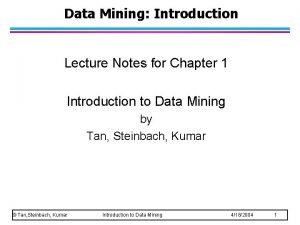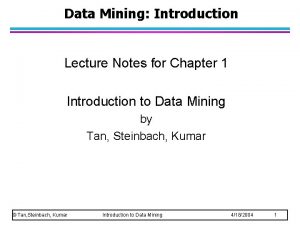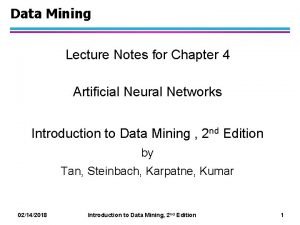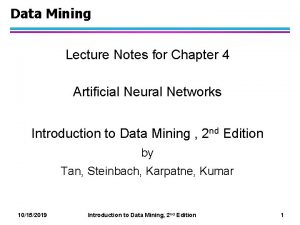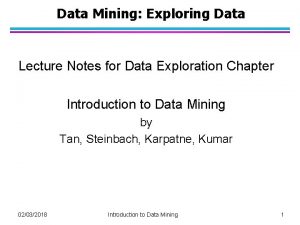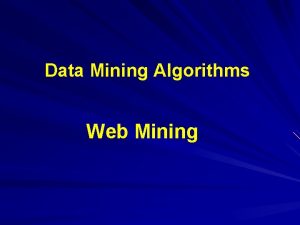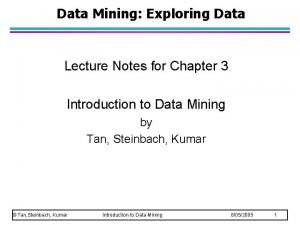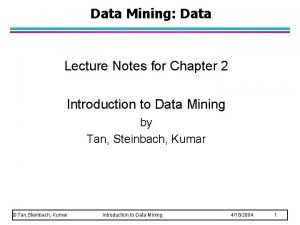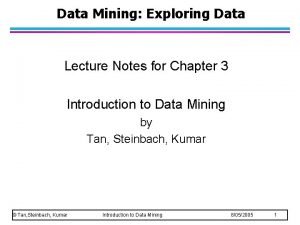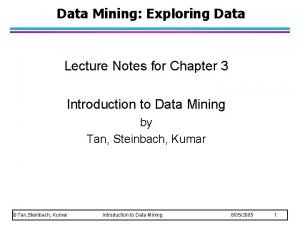Data Mining Lecture Notes for Chapter 4 Artificial






















- Slides: 22

Data Mining Lecture Notes for Chapter 4 Artificial Neural Networks Introduction to Data Mining , 2 nd Edition by Tan, Steinbach, Karpatne, Kumar 2/22/2021 Introduction to Data Mining, 2 nd Edition 1

Artificial Neural Networks (ANN) l Basic Idea: A complex non-linear function can be learned as a composition of simple processing units l ANN is a collection of simple processing units (nodes) that are connected by directed links (edges) – Every node receives signals from incoming edges, performs computations, and transmits signals to outgoing edges – Analogous to human brain where nodes are neurons and signals are electrical impulses – Weight of an edge determines the strength of connection between the nodes l Simplest ANN: Perceptron (single neuron) 2/22/2021 Introduction to Data Mining, 2 nd Edition 2

Basic Architecture of Perceptron Activation Function l l Learns linear decision boundaries Related to logistic regression (activation function is sign instead of sigmoid) 2/22/2021 Introduction to Data Mining, 2 nd Edition 3

Perceptron Example Output Y is 1 if at least two of the three inputs are equal to 1. 2/22/2021 Introduction to Data Mining, 2 nd Edition 4

Perceptron Example 2/22/2021 Introduction to Data Mining, 2 nd Edition 5

Perceptron Learning Rule l 2/22/2021 Introduction to Data Mining, 2 nd Edition 6

Perceptron Learning Rule l 2/22/2021 Introduction to Data Mining, 2 nd Edition 7

Example of Perceptron Learning Weight updates over first epoch 2/22/2021 Introduction to Data Mining, 2 nd Edition Weight updates over all epochs 8

Perceptron Learning l Since y is a linear combination of input variables, decision boundary is linear 2/22/2021 Introduction to Data Mining, 2 nd Edition 9

Nonlinearly Separable Data For nonlinearly separable problems, perceptron learning algorithm will fail because no linear hyperplane can separate the data perfectly XOR Data 2/22/2021 Introduction to Data Mining, 2 nd Edition 10

Multi-layer Neural Network 2/22/2021 l More than one hidden layer of computing nodes l Every node in a hidden layer operates on activations from preceding layer and transmits activations forward to nodes of next layer l Also referred to as “feedforward neural networks” Introduction to Data Mining, 2 nd Edition 11

Multi-layer Neural Network l Multi-layer neural networks with at least one hidden layer can solve any type of classification task involving nonlinear decision surfaces XOR Data 2/22/2021 Introduction to Data Mining, 2 nd Edition 12

Why Multiple Hidden Layers? l l Activations at hidden layers can be viewed as features extracted as functions of inputs Every hidden layer represents a level of abstraction – Complex features are compositions of simpler features l Number of layers is known as depth of ANN – Deeper networks express complex hierarchy of features 2/22/2021 Introduction to Data Mining, 2 nd Edition 13

Multi-Layer Network Architecture Activation value at node i at layer l 2/22/2021 Activation Function Introduction to Data Mining, 2 nd Edition Linear Predictor 14

Activation Functions 2/22/2021 Introduction to Data Mining, 2 nd Edition 15

Learning Multi-layer Neural Network l 2/22/2021 Introduction to Data Mining, 2 nd Edition 16

Gradient Descent l Loss Function to measure errors across all training points Squared Loss: l Gradient descent: Update parameters in the direction of “maximum descent” in the loss function across all points l Stochastic gradient descent (SGD): update the weight for every instance (minibatch SGD: update over min-batches of instances) 2/22/2021 Introduction to Data Mining, 2 nd Edition 17

Computing Gradients l 2/22/2021 Introduction to Data Mining, 2 nd Edition 18

Backpropagation Algorithm l 2/22/2021 Introduction to Data Mining, 2 nd Edition 19

Design Issues in ANN l Number of nodes in input layer – One input node per binary/continuous attribute – k or log 2 k nodes for each categorical attribute with k values l Number of nodes in output layer – One output for binary class problem – k or log 2 k nodes for k-class problem l l l Number of hidden layers and nodes per layer Initial weights and biases Learning rate, max. number of epochs, mini-batch size for mini-batch SGD, … 2/22/2021 Introduction to Data Mining, 2 nd Edition 20

Characteristics of ANN l Multilayer ANN are universal approximators but could suffer from overfitting if the network is too large – Naturally represents a hierarchy of features at multiple levels of abstractions l l Gradient descent may converge to local minimum Model building is compute intensive, but testing is fast Can handle redundant and irrelevant attributes because weights are automatically learnt for all attributes Sensitive to noise in training data – This issue can be addressed by incorporating model complexity in the loss function l Difficult to handle missing attributes 2/22/2021 Introduction to Data Mining, 2 nd Edition 21

Deep Learning Trends l Training deep neural networks (more than 5 -10 layers) could only be possible in recent times with: – Faster computing resources (GPU) – Larger labeled training sets l Algorithmic Improvements in Deep Learning – Responsive activation functions (e. g. , RELU) – Regularization (e. g. , Dropout) – Supervised pre-training – Unsupervised pre-training (auto-encoders) l Specialized ANN Architectures: – Convolutional Neural Networks (for image data) – Recurrent Neural Networks (for sequence data) – Residual Networks (with skip connections) l Generative Models: Generative Adversarial Networks 2/22/2021 Introduction to Data Mining, 2 nd Edition 22
 Bayesian classification in data mining lecture notes
Bayesian classification in data mining lecture notes Data mining lecture notes
Data mining lecture notes Data mining lecture notes
Data mining lecture notes Data mining lecture notes
Data mining lecture notes Mining complex types of data
Mining complex types of data 01:640:244 lecture notes - lecture 15: plat, idah, farad
01:640:244 lecture notes - lecture 15: plat, idah, farad Artificial neural network in data mining
Artificial neural network in data mining Mining multimedia databases in data mining
Mining multimedia databases in data mining Exploratory data analysis lecture notes
Exploratory data analysis lecture notes Strip mining vs open pit mining
Strip mining vs open pit mining Chapter 13 mineral resources and mining
Chapter 13 mineral resources and mining Difference between strip mining and open pit mining
Difference between strip mining and open pit mining Web text mining
Web text mining Data reduction in data mining
Data reduction in data mining What is data mining and data warehousing
What is data mining and data warehousing What is missing data in data mining
What is missing data in data mining Concept hierarchy generation for nominal data
Concept hierarchy generation for nominal data Data reduction in data mining
Data reduction in data mining Data reduction in data mining
Data reduction in data mining Shell cube in data mining
Shell cube in data mining Data reduction in data mining
Data reduction in data mining Data warehouse dan data mining
Data warehouse dan data mining Perbedaan data warehouse dan data mining
Perbedaan data warehouse dan data mining


